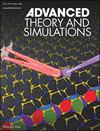Tuning of Optoelectronic Properties of Chalcohalides by Tailoring Pnictogen Composition for Sustainable Photovoltaics
IF 2.9
4区 工程技术
Q1 MULTIDISCIPLINARY SCIENCES
引用次数: 0
Abstract
This study investigates Sb1-xBixSeI pnictogen chalcohalides as lead-free materials for photovoltaic and optoelectronic applications using density functional theory (DFT) calculations. Increasing Bi content from 0.5 to 0.6 reduces the bandgap from 1.60 to 1.43 eV, enhancing the light absorption and aligning with the optimal range for solar energy conversions. Structural analysis reveals that higher Bi substitution expands the lattice, reduces the hole effective mass, and improves the hole mobility, while the electron mobility decreases slightly. Sb0.4Bi0.6SeI demonstrates quasi-direct bandgap characteristics attributed to Bi-induced lattice distortion and strong spin–orbit coupling (SOC), which reduces the conduction band minimum and facilitate direct-like electronic transitions. Enhanced absorption near the band edge and localized states contribute to higher sub-bandgap absorption, broadening the spectral response. Reduced bandgap falls within the optimal range for single-junction solar cells, increasing photocurrent generation. While defect-induced recombination poses challenges, passivation and compositional tuning can optimize its performance. This study identifies the potential of Sb0.4Bi0.6SeI as a versatile absorber material in emerging solar cell architectures. The findings provide a pathway toward designing cost-effective and sustainable materials with tailored properties for next-generation photovoltaic and optoelectronic technologies.

通过调整可持续性光伏发电的pnicogen组成来调整chalhalides的光电性能
本研究利用密度泛函理论(DFT)计算研究了Sb1-xBixSeI烟原硫化物作为光伏和光电子应用的无铅材料。将Bi含量从0.5增加到0.6,使带隙从1.60 eV减少到1.43 eV,增强了光吸收,符合太阳能转换的最佳范围。结构分析表明,较高的铋取代使晶格膨胀,空穴有效质量降低,空穴迁移率提高,而电子迁移率略有下降。Sb0.4Bi0.6SeI表现出准直接带隙特性,这是由于bi诱导的晶格畸变和强自旋轨道耦合(SOC),这降低了导带最小值,促进了类似直接的电子跃迁。带边附近的吸收增强和局域态有助于更高的亚带隙吸收,拓宽了光谱响应。减小的带隙落在单结太阳能电池的最佳范围内,增加了光电流的产生。虽然缺陷引起的复合带来了挑战,但钝化和成分调优可以优化其性能。本研究确定了Sb0.4Bi0.6SeI作为新兴太阳能电池结构中多功能吸收材料的潜力。这一发现为设计具有成本效益和可持续性的材料提供了一条途径,这些材料具有适合下一代光伏和光电子技术的特性。
本文章由计算机程序翻译,如有差异,请以英文原文为准。
求助全文
约1分钟内获得全文
求助全文
来源期刊

Advanced Theory and Simulations
Multidisciplinary-Multidisciplinary
CiteScore
5.50
自引率
3.00%
发文量
221
期刊介绍:
Advanced Theory and Simulations is an interdisciplinary, international, English-language journal that publishes high-quality scientific results focusing on the development and application of theoretical methods, modeling and simulation approaches in all natural science and medicine areas, including:
materials, chemistry, condensed matter physics
engineering, energy
life science, biology, medicine
atmospheric/environmental science, climate science
planetary science, astronomy, cosmology
method development, numerical methods, statistics
 求助内容:
求助内容: 应助结果提醒方式:
应助结果提醒方式:


